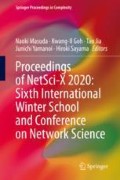Abstract
Input-output (IO) tables provide a standardised way of looking at interconnections between all industries in an economy, and are often used to estimate the impact of disruptions or shocks on economies. IO tables can be thought of as networks—with the nodes being different industries and the edges being the flows between them. We develop a network-based analysis to consider a multi-regional IO network at regional and sub-regional level within a country. We calculate both linear matrix-based IO measures (‘multipliers’) and new network theory-based measures, and contrast these measures with the results of a disruption model applied to the same IO network. We find that path-based measures (betweenness and closeness) identify the same priority industries as the simulated disruption modelling, while eigenvector-type centrality measures give results comparable to traditional IO multipliers, which are dominated by overall industry strength.
Access this chapter
Tax calculation will be finalised at checkout
Purchases are for personal use only
References
Acemoglu, D., Carvalho, V.M., Ozdaglar, A., TahbazSalehi, A.: The network origins of aggregate fluctuations. Econometrica 80, 1977–2016 (2012). https://doi.org/10.3982/ECTA9623
Blöchl, F., Theis, F.J., Vega-Redondo, F., Fisher, E.O.N.: Vertex centralities in input-output networks reveal the structure of modern economies. Phys. Rev. E 83(4), 046127 (2011)
Cerina, F., Zhu, Z., Chessa, A., Riccaboni, M.: World input-output network. PLoS One 10(7), e0134025 (2015)
Contreras, M.G.A., Fagiolo, G.: Propagation of economic shocks in input-output networks: a cross-country analysis. Phys. Rev. E 90(6), 062812 (2014)
Csardi G., Nepusz T.: The igraph software package for complex network research. InterJ. Complex Syst. 1695 (2006). http://igraph.org
Dietzenbacher, E., Miller, R.E.: Reflections on the inoperability input-output model. Econ. Syst. Res. 27(4), 478–486 (2015). https://doi.org/10.1080/09535314.2015.1052375
Harvey, E.P., Mead, S., Ayers, M.A., Smith, N.S., McDonald, G.M.: Quantifying the flow-on impacts from short-term natural hazard disruptions in local economies within New Zealand. (in preparation)
Hausmann, R., Hidalgo, C.: The network structure of economic output. J. Econ. Growth 16(4), 309–342 (2011)
Hill, M.O.: Diversity and evenness: a unifying notation and its consequences. Ecology 54, 427–432 (1973)
Kendall, M.: A new measure of rank correlation. Biometrika 30(1–2), 8189 (1938). https://doi.org/10.1093/biomet/30.1-2.81
Liang, S., Qu, S., Xu, M.: Betweenness-based method to identify critical transmission sectors for supply chain environmental pressure mitigation. Environ. Sci. Technol. 50, 1330–1337 (2016)
McNerney, J.: Network properties of economic input-output networks. IASA Interim Report. IIASA, Laxenburg (2009)
McNerney, J., Fath, B.D., Silverberg, G.: Network structure of inter-industry flows. Phys. A Stat. Mech. Appl. 392(24), 6427–6441 (2013)
Miller, R.E., Blair, P.D.: Input-Output Analysis Foundations and Extensions, 2nd edn. Cambridge University Press, Cambridge (2009)
Oosterhaven, J.: On the limited usability of the inoperability IO model. Econ. Syst. Res. 29(3), 452–461 (2017). https://doi.org/10.1080/09535314.2017.1301395
Xu, M., Allenby, B.R., Crittenden, J.C.: Interconnectedness and resilience of the US economy. Adv. Complex Syst. 14(5), 649–672 (2011)
Acknowledgements
Resilience to Nature’s Challenges - National Science Challenge contestable funding 2017–2019. Ministry of Business, Innovation & Employment, NZ. http://resiliencechallenge.nz
Te Pūnaha Matatini, Centre of Research Excellence, Tertiary Education Commission, NZ. https://www.tepunahamatatini.ac.nz
Author information
Authors and Affiliations
Corresponding author
Editor information
Editors and Affiliations
Rights and permissions
Copyright information
© 2020 Springer Nature Switzerland AG
About this paper
Cite this paper
Harvey, E.P., O’Neale, D.R.J. (2020). Using Network Science to Quantify Economic Disruptions in Regional Input-Output Networks. In: Masuda, N., Goh, KI., Jia, T., Yamanoi, J., Sayama, H. (eds) Proceedings of NetSci-X 2020: Sixth International Winter School and Conference on Network Science. NetSci-X 2020. Springer Proceedings in Complexity. Springer, Cham. https://doi.org/10.1007/978-3-030-38965-9_18
Download citation
DOI: https://doi.org/10.1007/978-3-030-38965-9_18
Published:
Publisher Name: Springer, Cham
Print ISBN: 978-3-030-38964-2
Online ISBN: 978-3-030-38965-9
eBook Packages: Physics and AstronomyPhysics and Astronomy (R0)

